Quick energy boosters in front of the screen
The gaze is concentrated on the screen. Movement limited to frugal typing on the keyboard. Passively taking things in for long periods of time. That‘ s where an energiser comes in handy. We asked our colleagues and collected some: Energisers for online training.
Virtual skiing
I learned virtual skiing from colleague Tanja Friederichs. First there is some short warm-up gymnastics in a standing position: Shaking out hands and legs, stretching, hip circles, jumps etc. And then it’s off to practice: with a men’s downhill in St. Moritz! She fades in a Youtube video and we race along standing (or rather squatting and jumping) in front of our laptops. Virtually, we can ski all year round!
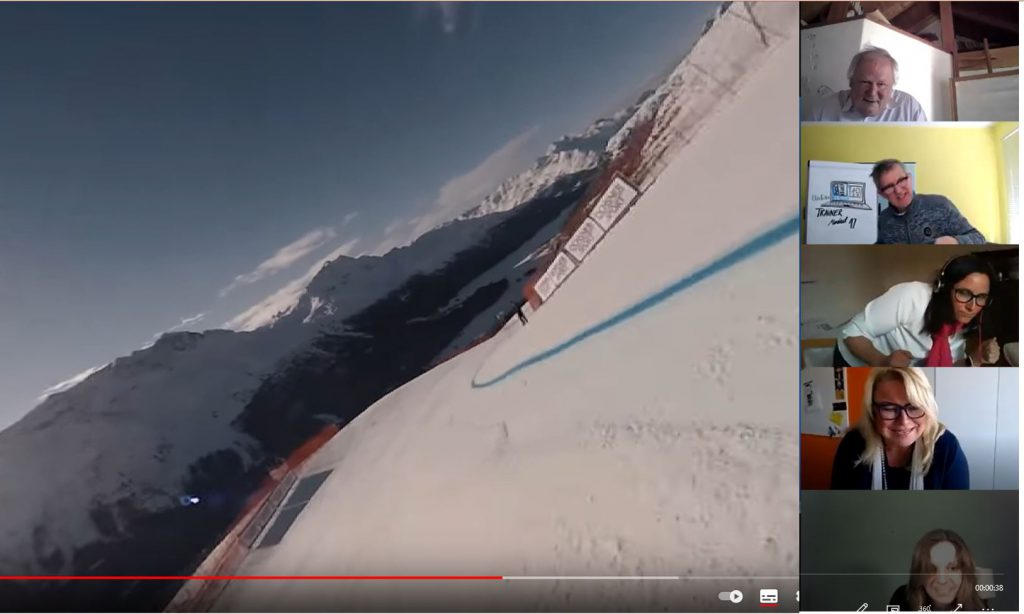
Movement on cue
Prepare cards to hold up to the camera. If you still have moderation cards from analogue times, these are the easiest to use, otherwise you can find a printable template as a PDF below.
Here’s what to do: For RED, everyone taps each other on the head with the flat of their hand; for GREEN, both earlobes are touched. For BLUE you rub your shoulder, for YELLOW you clap your hands. Rule: The decisive factor is always the text on the card, not the colour.
In the tile view, this is practised with the simple cards (colour and text identical) in two rounds. Then it starts. Whoever makes a mistake turns off the camera. It’s always exciting to see how many are still at it after five minutes. (Thanks Michael Ziereis)

| Yellow: Clap your hands! Green: Touch both earlobes! | Red: Tap your head with the flat of your hand! Blue: Rub your shoulders! |
Let the participants do it!
Energisers are usually done by the facilitator – with the risk that the group may not like it. Let’s leave Energizer to the participants in longer trainings or courses! This works online and in presence, as Elisabeth Steinklammer reports:
„At the BRAK (BetriebsrätInnenAkademie in Vienna) 2020, participants were very creative when it came to lightening the mood. They set a different motto every day: Sometimes it was (virtual) disguises (e.g. people wearing beards or creative headgear), sometimes it was favourite bands, favourite books (everyone changed their name to the name of their favourite band with the camera switched off and the others could guess who was behind it), sometimes it was stuffed animals, pets, work utensils that were ready when logging in and shown to the others. The idea came from one of the participants and from our perspective it was extremely good for the group. Not only did it lighten the mood, but they got to know each other in a different way and connect with each other without being in the same place.“
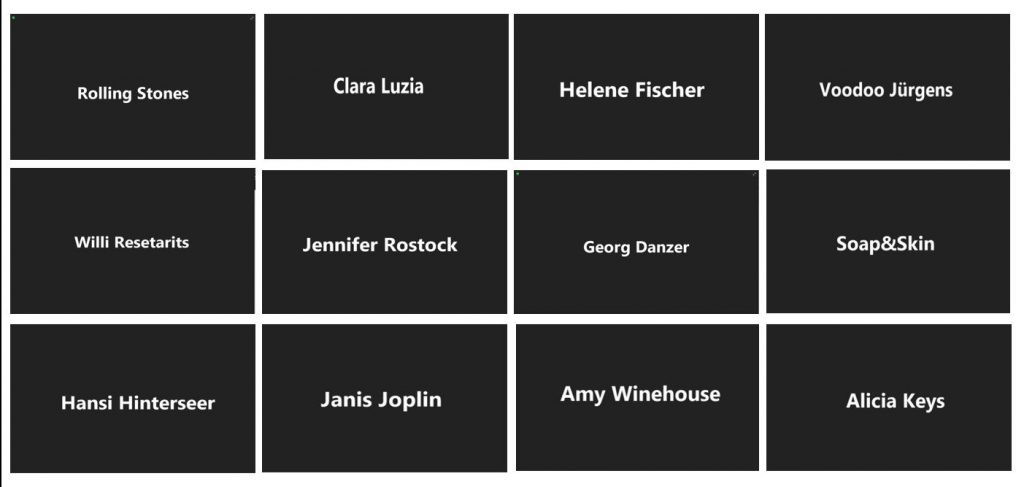
That’s what I want!
Sonia Weidenmann lets her participants think creatively and presents them with a challenging task: „Inspire us with an – at first glance – useless object. We have to want to have it at all costs!“ Examples: Blown out balloon, used chewing gum, 5m of string, a crown cap, 10kg of cooked spaghetti, 1 bucket of petals, 1 cent, two boiled eggs, full hoover bag, etc. The more „absurd“ the objects, the better.
Each person has one minute to present an item to the group in a way that makes you think: „Wow, I really need that! The time is stopped and the feedback („Yes, I do!“) comes from the group via applause and cheers. Sonia: „The whole thing is challenging and very entertaining at the same time. I like to use the exercise as an energiser or also to introduce a topic such as communication/ convincing/ inspiring people/ change of perspective.“
Details on the use: „The objects are distributed randomly. Of course, the whole thing lives from the staging! As a facilitator, I make sure that the atmosphere is light-hearted and humorous, because the creative thinking of the participants should be activated. You can also think of something creative to assign the objects, like in a game show. I had written them on cards, put them in different coloured envelopes, held them up to the camera and whoever had their turn then chose an envelope by colour. It also works with numbers, letters, an interactive wheel of fortune or simply a split presentation (like Jeopardy or PowerPoint Karaoke). The main thing is chance and surprise.
The applause strength is measured by feel, you can also make smileys in the chat as feedback. Preferably, however, it’s more about the mood in the group and that people also become physically active by cheering. Who wins in the end is not so important – the fun, the activation and the thinking around corners are in the foreground.“
Uwe’s puzzle corner
Uwe Hildach trains hazardous goods topics. This entails a lot of detailed knowledge, the conveying of (at first glance) unattractive regulations, and legally required refresher courses. Participants love Uwe’s seminars because he spices them up with puzzles, quizzes and fun.
Ds Spl hn Vkl. It’s hard to figure out. Maybe by pointing out that only the vowels are missing here in the „Spiel ohne Vokale“ (= Game without Vocals). Here is an example from Uwe’s dangerous goods topics:

This is not just an energiser. This exercise can be used to rpt and nkr technical terms.
Thinking around the corner. Logical thinking is only of limited help here:

Fold one of the sticks over so that it forms a square.
Draw a square with only three strokes.
Correct this mathematical problem with one stroke.
By the way, Uwe can also read minds and also makes us „fit in foreign languages„.
Counter-power with matches
Counter power is a central concept in the ÖGB (Austrian Association of Trade Unions). I asked trade unionists to depict this term, which is familiar to them, with matches or toothpicks.

The practical question: How does the result get onto the screen in online mode? Simple: take a picture with your mobile phone and hold it up to the camera in galery view. Or put the picture on a whiteboard. It’s very easy to do this with Strange Garden, a whiteboard that makes it child’s play to present and merge mobile phone photos. (Thanks to Pia Lichtblau)
Puzzle
Puzzle is also possible online. Pictures need a URL, then you can create a puzzle yourself. Playing is also possible in multiplayer mode. Thank you Uwe Hildach!
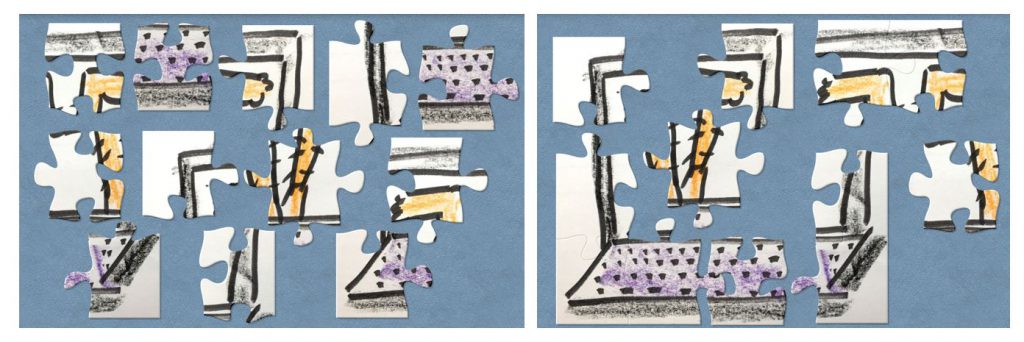
Heiko’s finger zigzag

It looks easy in the video, but it takes practice to get the hang of it. Of course it works better if we demonstrate it ourselves, but in a pinch just show the video. Heiko Mielke is a clown and also works with Clowns without Borders.
Getting participants to talk
After the lunch break, the trainer pops in questions. For example: „This really surprised me last week“. Elisabeth Steinklammer reports: „All participants took their turn. The trainer Margret Steixner triggered the random generator to determine the order and then a question came up. The person whose turn it was answered the question and then the next one followed. It was a fine way to start after lunch, woke me up myself and I got to know the other people present a bit better.“
It’s good if the questions are tailored to the group and/or the content. But there are also general templates as a suggestion such as for start-up situations: for example this one or also this one. Fortunately, both are in English.
We like to use the Random Picker Wheel as a random generator because it is so easy to use. A bit more playful (e.g. photos instead of names are possible) is the Wheel of Names.
Michael Ziereis puts many questions on the whiteboard (here miro) and lets the participants choose what they want to answer with name cards. He likes to do this at the beginning of the second day. The advantage here: No one has to feel ambushed.
The basic principle is that of the flash: there is a question and everyone answers in turn. That has worn out a bit. The variations shown here are more attractive and bring more energy – also in presence mode.
Picture Puzzles & Change
You all know picture puzzles. Seemingly the same picture twice. But there are changes in the second picture and you have to find them.
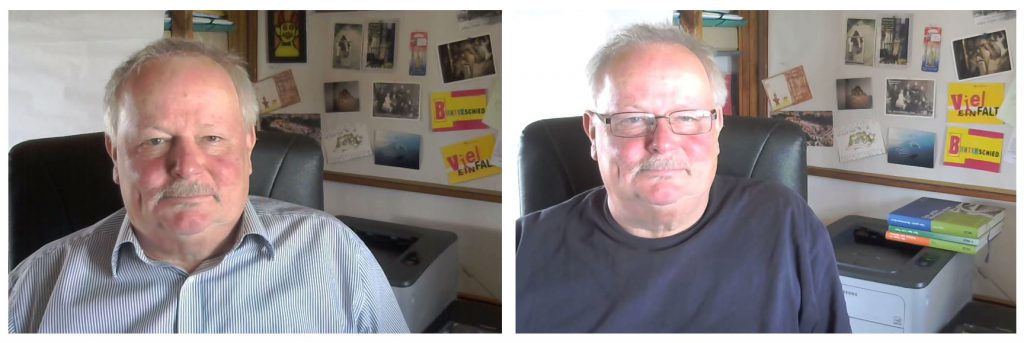
Regina Czurda was inspired by the book „80 Games for Live Online Training“ (see below). The starting point is the principle of picture puzzles.
„There are about five active participants, the others watch with the camera switched off.
1. All five switch on the camera and have max. 60 seconds to memorise the pictures of the other four.
2. Then the cameras are switched off and each of the five has 30 seconds to change three things in the visible part of the picture (camera position must not be changed)
3. Then the five turn the camera back on and try to name all the changes. If there are more than five participants, the next five will follow the same procedure. There should not be more than 15 people in total.
The important thing is to reflect afterwards. Here are some suggestions:
- What was the biggest challenge in this game?
- What ideas & changes emerged?
…a lot of the changes were already reversed during the reflection round:
- What happened to the changes?
- Why were the changes reversed?
- What does this mean for successful, successful and sustainable change?
Tips for energiser use!
- Remember the allergy potential of „games“. Even in the online format, energisers are „annoying“ to some people.
- Justify the use! We’ve been sitting too long again, so I want to get you moving.
- Those who want to, join in. Those who don’t want to, won’t get involved because of it, and certainly don’t get exposed.
- Energisers related to a topic are better than those without. Ideally, the training/lecture should be designed in such an activating way that additional energisers are superfluous. Ideas for activation can be found here.
- Basically: energisers must not become a purpose in themselves. They bring energy into the learning process, loosen up, promote concentration and joy of learning among the participants. If this does not work or is not necessary, we do not need energisers.
Tips for further reading:
- Gert Schilling, Hrsg. (2021): 80 Spiele fürs Live-Online-Training. Verlag: managerSeminare.
Reading sample
Regina Czurda took a look at the book: „I think the book is a great collection of (partly well-known) activations for more variety in online training. The division of the exercises into 3 categories – from a quick loosening up to reflections with depth – makes orientation easier. I found it particularly helpful that you can see at a glance how many participants each method is suitable for and how much time you should plan for. This also makes the book easy to use as a reference book.“ - Caspar Siebel (2020): Das Wilde Workshop-Spiele Buch, ISBN: 9783000650888 (A new edition will be published soon)
- The website of the book with many examples
- Online energisers: A rich site (in English). I like „Dance, Dance, Dance“, even if it is not suitable for all target groups. (Thanks Daniela Schratter)
- A collection of practical tools for training online that go beyond energisers can be found on the website god digital. „…don’t be afraid – god digital – it’s also about online church services – but there are great ideas,“ writes Margret Steixner, who gave us this tip.
- Energisers can as well be found in other blog posts, e.g. „Breaks online“ with instructions on how to move before and away from the computer. There is the instruction for puzzling online, a very quick and uncomplicated energiser.
Author: Ulli Lipp, who thanks the many people who gave tips.
Lust auf mehr? Zu allen Einträgen der Serie #mm kommst du HIER!

Dieses Werk ist lizenziert unter einer Creative Commons Namensnennung-NichtKommerziell-Weitergabe unter gleichen Bedingungen unter gleichen Bedingungen 3.0 Österreich Lizenz.
Volltext der Lizenz

Dieses Werk ist lizenziert unter einer Creative Commons Namensnennung-NichtKommerziell-Weitergabe unter gleichen Bedingungen unter gleichen Bedingungen 3.0 Österreich Lizenz.
Volltext der Lizenz

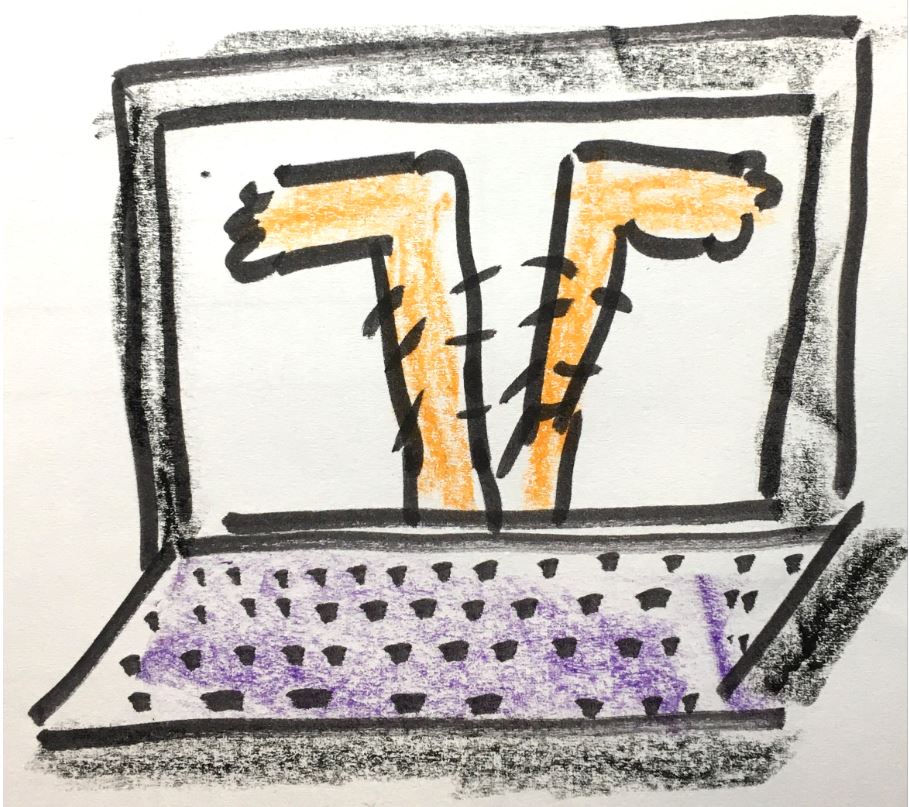

Howdy! Someone in my Facebook group shared this site with us so I came to check it out.
I’m definitely enjoying the information. I’m book-marking and will be tweeting this to
my followers! Fantastic blog and wonderful design and style.
Hi, yeah this piece of writing is really good and I
have learned lot of things from it concerning blogging.
thanks.